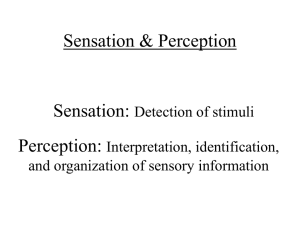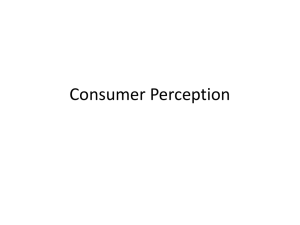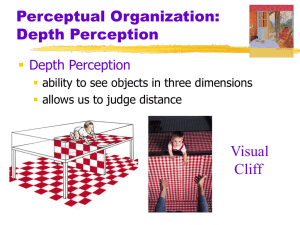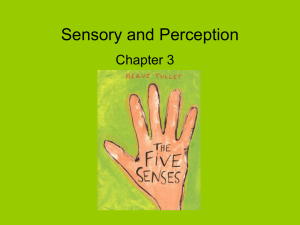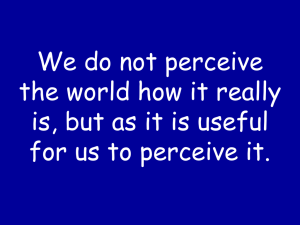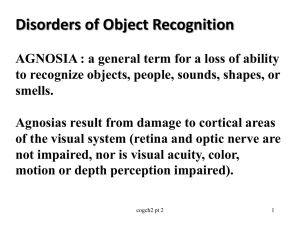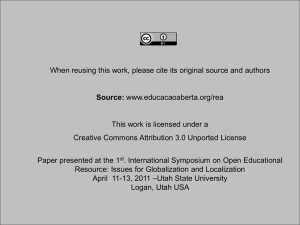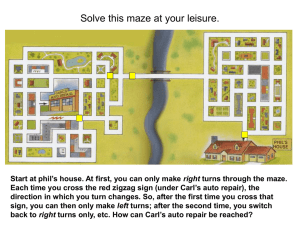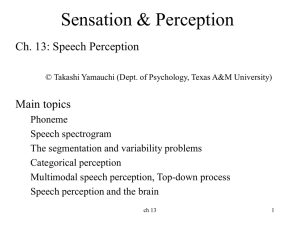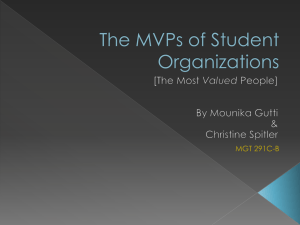File - IISWBM EVE Website
advertisement
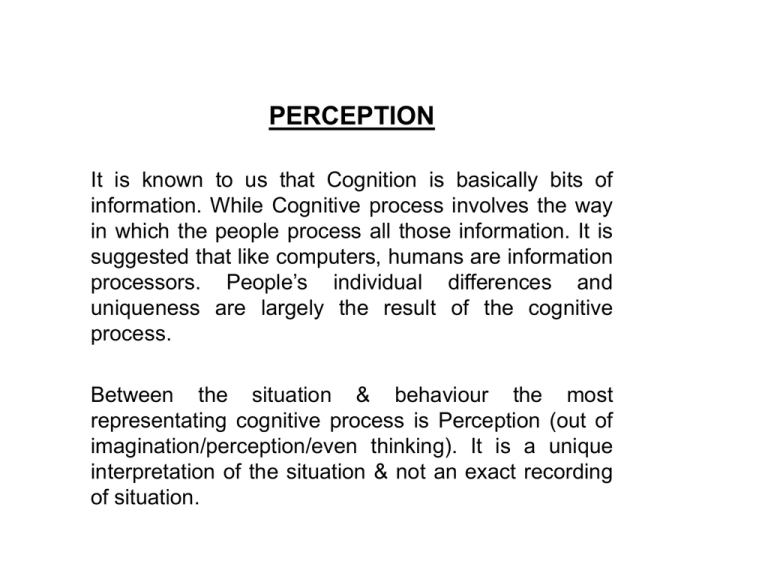
PERCEPTION It is known to us that Cognition is basically bits of information. While Cognitive process involves the way in which the people process all those information. It is suggested that like computers, humans are information processors. People’s individual differences and uniqueness are largely the result of the cognitive process. Between the situation & behaviour the most representating cognitive process is Perception (out of imagination/perception/even thinking). It is a unique interpretation of the situation & not an exact recording of situation. For example; Promotion policy Manager feels Subordinate always want promotion Subordinate feels Psychologically forced to take promotion. Perception can be represented as follows : Stimuli like : noise/touch/sight/ smell/taste/ or any other through our sense of organ(Nose/Skin/Hearing/vision/tongue) constantly bombarded on individuals Individual process these information through psychological manner The process is known as perception. Perception begins when an person is confronted with a stimulus or a situation. Thus perception is the meaning of the situation or sensation. This meaning built- up from past experience. Thus Sensation + Meaning = Perception. It can also be illustrated as the ability of an individual to predict a sensation on the basis of past experience. e.g. when in a room we put on the switch of a light within a fraction of a second we understand that whether light is from Filament lamp or Florescence one. Obviously when we understand the meaning of a situation we react on the basis of our past experience. However, in case of an adult person who is a mature one , there is hardly any difference between sensation & perception. While for a newly born baby, when he/she recognize a sensation in the same pattern – we call it is his perception. Usually a baby start recognition of a sensation of feeding & perception after 36 hours of his birth. Definition : Perception is a process by which individual organize & interpret their sensory impressions in order to give meaning to their environment. Perception about a thing changes with time. But if a person changes his perception very frequently then we call him an undependable or inconsistent person. Elements of perception : It includes 5 - elements. Stimuli RegistrationSelection Feedback Action/Reaction (external) or or or (external) Receiving Interpretation Organizing (covert/overt) Internal (sub – process) In an organizational situation Supervisor may form the stimulus situation for the workers perceptual process. • Registration involves Physiological mechanism including both sensory & neutral e.g. individual’s ability to see/ to hear. • Interpretation is the most important sub process. Interpretation of stimuli determined by individuals learning/motivation/personality. • Feedback is the psychological sub process direct the individual as to what to do or how to behave. External Environment Perception with respect to S.O.B.C. model : O S Regisstration of Confrontation Stimulus Interpretation Senatoional New environment Of stimulus Stimulus (Changed office time) (motivation/ Personality/ Physical Learning) Environment (office timing) Feed back Sociocultuaral Environment (Mgmt. Style) (for classification) B Behaviour Consequence (Grp. discussion) mgmt.) + Gathering C (agitation with Sensation vs. Perception : • • • Five senses i.e. vision, touch, smell, taste, & hearing are constantly bombarded by Outside stimuli are light waves, sound waves, mechanical energy of pressure or chemical energy from objects (in the form of smell & taste). Inside stimuli are energy generated by muscles / food passes through intestine/ glands secreting behaviour – influencing hormones. • Thus sensation deals with very elementary behaviour that is largely by physiological functioning of human beings experience on colour/ brightness / shape/ loudness / heat odour / taste. • Where as perception is a more complex psychological process. It is the interaction of Selection --- Organization --- Interpretation with respect of sensation. • Senses are the raw material / data which under Cognitive process will filter or modify or completely change. e.g. the purchase manager buys a m/c. spares that he thinks best & not to one that the engineer says is best. Perceptual Selectivity : Several stimuli are affecting an individual at a any point of time. However, only a few stimuli are being select out by the individual at that point of time. This is because a no. of factors affect/influence on perception of an individual. These factors are : The Perceiver (internal) The object or target (external) The situation (external) Following are the external & internal factors be studied in detail External Internal Intensity Learning Size Perceptual set Contrast Motivation Repetition Personality Motion Novelty & familiarity Intensity : Greater the intensity of external stimulus higher will be chance of perception or more likely it is to be perceived. Like – loud noise, strong odour, bright light etc. e.g. Advertiser ´s use intensity to gain consumers attention. T.V. commercials are slightly louder than the regular programme. Bright packaging. Size : Bigger the size of the stimulus, higher will be the probability to perceive it. 1. The maintenance engineering staff pay more attention to a big m/c. than to a smaller one, even when the smaller is costlier. 2. In advertising, a full page spread is more – attention – getting than a few lines in classified section. Contrast : It is the presentation pattern of stimuli. External stimuli which stand out against the background or which are not what people are expecting will receive their attention. Plant safety signs with black lettering on yellow background or white lettering on red-background are attention getting. Black circles of similar size will attract in different way because of their contrast. In an experiment the workers on training in a quite /clean /noise free classroom were shown a poor performance while in the noisy shop floor they shown satisfactory performance. This is as because they are accustomed with noises Repetation : A repeated external stimulus is more attention-getting than a single one. Repetition increases our sensitivity or alertness to the stimulus. Advertiser create a unique image for a product which is different from its competitors. Motion : People will pay more attention to moving objects in their field of vision than they will to stationary objects. Novelty & Familiarity : Either a novel or a familiar external situation can serve as an attention greater. Following cases will draw the attention of the Perceiver: New object or event in a familiar setting. Familiar object or event in a new setting. This approach of perceptual selectivity helps in ´´Brand loyalty´´. Set : The concept of set is an important cognition in selectivity. It can be thought of as an internal form of attention getting. It depends on 1. The individual’s complex psychological makeup. 2. People will select out stimuli or situation from the environment that appeal to & compatible with their learning, motivation & with their personality Learning : What one has acquired from his childhood through his surroundings. It is the single biggest role in developing perceptual set. It can be illustrate as – 1. ´´ MACHINERY´´ ´´Mac-Hinery´´ This view states simply that people see & hear what they expect to see & hear. 2. TURN ´´TURN OFF THE ENGINE´´ OFF THE ENGINE This illustrate that learning affects set by creating an expectancy to perceive in a certain manner. Perceptual Set : Selection of a stimuli (commodity) based on previous experience. In organisations some employees may perceive world around them in a particular manner. Perceptual differences are a major explanation for industrial disputes – Management & Union members may perceived a situation in different manner. e.g Poor output record in the production department of a manufacturing plant – may be perceived by different persons in different way , 1. The Engineer perceives the solution to this problem as one of improved machine design. 2. The Personnel manager perceives the solution as one of more training & better wage incentives. 3. H.O.D. perceives the solution to be more effective organizing, planning & control. 4. On the other hand the workers may perceive the low output as pleasure as the supervisor will be in trouble to make explanation, whom they dislike most. Motivation : It has a vital impact on perceptual selectivity. Highly motivated person on perceiving a favorable situation, try to adhere to it – as we know if there is a need there will be a force to achieve the desired target. This can be further illustrated by following examples1. If there is a great need for food then by mention/sight (vision)/ smell of food gives a great deal of attention. 2. A person who has a relatively high need for power, affiliation or achievement will be more attentive to relevant situational variables. For example a worker with strong need for affiliation when works into the canteen , the tables where maximum coworkers are sitting will be perceived. Personality : Optimistic people will perceive the things in favorable terms. While pessimistic people in negative terms. For example – 1. In a confronting situation, it is the personality of an individual to attend or percept. 2. The conflict between old & new generation workers is the resultant effect of this factor. 3. Perception of a modern movie to older people will be disgusting or not been able to understand. Perceptual Organization : Perceptual selectivity was concerned with the external & internal variables that gain an individual’s attention. Now, the focus will be on perceptual process, once the information from situation received. An individual seldom perceives patches of colour, light or sound. Instead the person will perceive organised patterns of stimuli & identifiable whole object. For example, in a football match we does not usually perceive the leather ball or colour of the dresses but perceive fun & excitement. It is one of the sub-process of perceptual process. Stimuli Actual transformation of these Resultant opinion, feelings (Perceptual inputs through perceptual attitude which influence our input) mechanism of selection, behaviour organisation & interpretation (Perceptual output) (Perceptual through puts) Among the all stimuli of the environment some are only selected & organised in some form, in order to make some sense out of them. This organisation of stimuli may take the form of – i) Figure Ground ii) Grouping iii) Simplification iv) Closure Figure ground : 1. It is the most basic form of Perceptual Organisation. 2. People wants to organise information in this principle. 3. It explains that while perceiving stimuli, individual tries to keep certain phenomenon in focus & other in the background. 4. More attention is paid on the phenomenon which have kept in focus or figure and less on the background. 5. Thus the principle simply means that perceived objects stand out as separable from their general background. 6. This can be explained while we read a text . In respect of light stimuli, the reader is receiving patches of irregularly shaped blacks & whites. But we perceive black shape – letter, word, sentencesprinted against white background. Thus the reader perceptually organises incoming stimuli into recognizable figures (words) that are seen against a ground (white page ). 7. The perception may change if certain stimuli are changed from figure to ground. e.g. in some organisation good performance (a figure for promotion in normal case) may be taken as ground & maintaining good relation with boss (ground in normal case) for promotion may be taken as figure. Grouping : 1. There is a tendency to group several stimuli together into a recognizable pattern. 2. The perceiver groups various stimuli on the basis of their similarity or proximity. 3. Thus all such stimuli which have been grouped are likely to be perceived as having same characteristics. e.g. All the workers may be perceived to have same opinion about the management because of grouping on the basis of similarity. OR All the persons coming from the same place may be perceived as having same characteristics because of the grouping on the basis of proximity. Grouping is based on – i) Continuity : A new design of productive process or product. ii) Proximity : Workers who worked on a particular machine may be perceived as a single whole. iii)Similarity : Workers with a particular colour uniform OR women OR minority. Simplification : 1. When ever people are overloaded with informations, they try to simplify it for making it more meaningful & understandable. 2. During this simplification process the perceiver subtracts less important informations while concentrate more in important one. 3. Simplification makes things more understandable as the perceiver able to reduce the complexity by reducing the number of informations of less importance. Closure : When faced with incomplete informations people will fill-up the gaps to make the information meaningful. e.g. In many advertisement alphabets are being made by electronic bulbs, which indicate the concerned alphabets. In such case people fill-up gaps between the bulbs to understand the meaning of alphabets. Perceptual Defense : A person may build a defense (block or refusal to recognize) against stimuli or situational events. It is in context that are personally or culturally unacceptable or threatening. Perceptual defense influence to understand the role of management- union / boss- subordinate relationship. Although some conflicting evidence is there in some studies, but the existence of perceptual defense mechanism has been established in almost all cases. Following are the three general explanations of perceptual defense – 1. Emotionally disturbing information has a higher threshold for recognition i.e. do not perceive readily than neutral or nondisturbing information. 2. Disturbing information & stimuli are likely to bring about substitute perceptions which are distorted to prevent recognition of disturbing elements. 3. Emotionally arousing information actually does arouse emotion even though the emotion is distorted or directed elsewhere. In a study Intelligent was considered as a characteristic of factory worker. The students response in this case was defensive & like : 1. Denial – A group of students denied the existence of intelligence in factory workers. 2. Modification & distortion - A group of students stated ´´ HE is intelligent but does not possess initiative to rise above his group´´. 3. Change in perception - A group of students change their stand & said ´Cracks Jokes´. 4. Recognition but refusal to change – Only a small group of students recognize that there is a conflict between their perception of the workers & the characteristics of ´Intelligent´. They said ´´ Most of the factory workers I have heard about are not too intelligent´´. Social Perception : It is directly concerned with how one individual perceives other individuals. Formal organizational participants are constantly perceiving one another e.g. Managers are perceiving workers & the Workers are perceiving the Managers. Factors found in the social perception are Psychological process & personality. Finding of a research work showed following characteristics are important to influence how a person perceives others in environment – i) Knowing oneself makes it easier to see others accurately. ii) One’s own characteristics affect the characteristics one is likely to see in others. iii) People who accept themselves are more likely to be able to see favorable aspects of other people. iv) Accuracy of perceiving others is not a single skill. Following characteristics of the individual being perceived were found influencing Social Perception – i) Status of the person will greatly influence other’s perception of him. ii)The person being perceived is usually placed into categories to simplify viewers perceptual activities. Two common categories are status & role. iii)The visible traits of the person perceived will greatly influence the perception of him. Organizational individuals perception as well as perception of others are greatly influenced by their characteristics & of others. e.g. If the manager feels good about himself & the subordinates are physically attractive, pleasant, then he will perceive the subordinates in a +ve & favorable manner. If the manager is down on himself & other subordinates are unattractive & / or arrogant, he will perceive them in `-ve & unfavorable manner. Practical application of Social Perceptions : A) Attribution : It refers to how a person explains the cause of another person’s behaviour. It is the process by which people draw conclusions about the factors that influence or make sense of another’s behaviour. Attributions are of two type : i) Dispositional type – It ascribe a person’s behaviour to internal factors e.g. Personality / Motivation. ii) Situational type – It ascribe a person’s behaviour to external factors e.g. Social influence from others. It plays important role in Motivation / Performance Appraisal / Leadership. B) Stereotyping : It is a perpetual error that developed in social perception. It refers the tendency to perceive another person (thus social perception) as belonging to a single class or category. It also implies general agreement on the attributed traits & the existence of a discrepancy between attributed traits & actual traits. Stereotyping is the assignment of favorable or un-favorable traits to a class of persons as a function of whether the observer has a +ve or –ve attitude towards the person category. Most often a person is put into a stereotype because the perceiver knows only the overall category to which the person belongs. However, every individual is unique. Thus real trait of the person be quite different from those the stereotype suggest e.g. Managers, Supervisors, Union-leaders, minorities, women, police. C) Hallo Effect : It is an error in Social perception. In Stereotype the individual is perceived on the basis of a single category. Whereas in Hallo Effect the person is perceived on the basis of single trait. It is often discussed in Performance Appraisal when a rater makes an error in judging a person’s total personality & / or performance on the basis of a simple trait viz. Intelligence, Appearance, Dependability or Co-operativeness. Whatever the single trait is, it override all other traits in forming the Perception of the person. ! Perceived as - Intelligent / Performer e.g. Attractive women secretary of a male boss ! ! Actually – Poor typist / quite dense This means looking at her & perceived as his secretary & not as an able manager to cope with important responsibilities is obviously an error. Thus one trait blind the perceiver to all other traits in the perpetual process. The traits of a Hallo : i) It is a common error. ii) It has both true & illusory components. iii) Lead to inflated correlation among rating dimensions. iv) –ve consequence & should be avoided. There are 3 – conditions under which Halo Effect most marked – i) When the traits to be perceived are unclear in behavioural expression. ii) When the traits are not frequently encountered by the perceiver. iii) When the traits have more moral implications.
